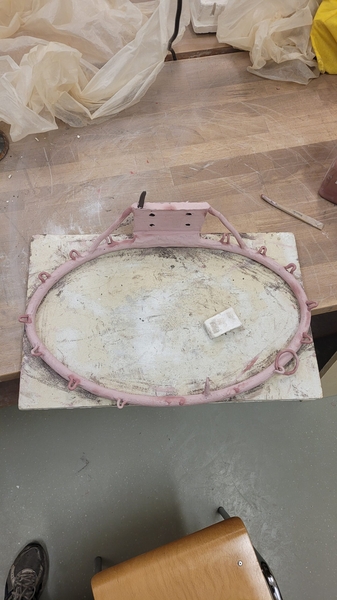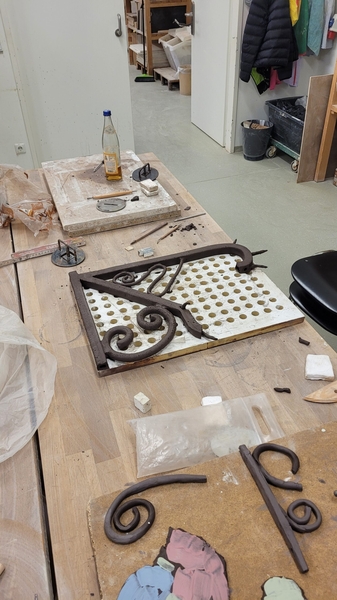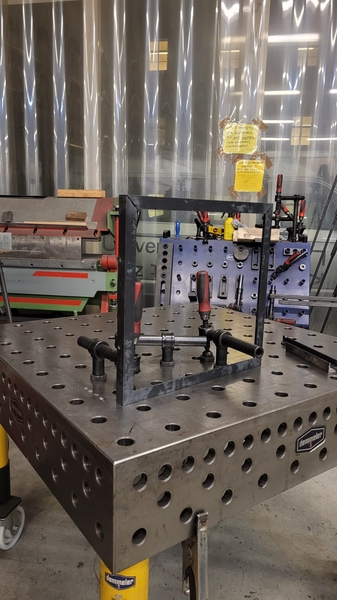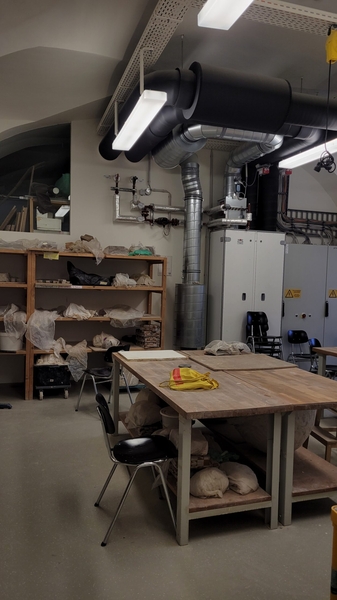Patrick Ostrowsky – Artist in Residence
October – December 2023
Für die deutsche Version bitte scrollen
The artistic work of Patrick Ostrowsky, born in the Bavarian Forest, utilises the means of sculpture, architecture, and installation. By combining a wide range of visual references, Ostrowsky explores his biographical details such as personal history, the do-it-yourself tradition of his Slavic origins and the socio-political experience of everyday life. In his artistic reflections, he explores the nature of human beings, such as identity, vulnerability, and relationships, as well as the relationship between human creativity and AI. Unlike humans, AI has no memory. It recalculates the optimal solution each time. At the heart of Ostrowsky’s expansive installations is the assertion that, contrary to the best of all feasible solutions, we should trust the intuitive, human, and endless attempt to create meaning.
His works create possible worlds that lie outside of standardised, conformist reality. Using found objects, such as discarded smartphones or fragments of his own memory, Patrick Ostrowsky explores the potential of storytelling. Using both formal and poetic language, soft materials such as clay, water or wax are encouraged to enter new relationships with hard substances such as metal or concrete. They confront visitors with their own existence and pose questions. Ultimately, Ostrowsky’s practice reflects on how much we can change ourselves when we learn to better understand materials and their historicity.
Patrick Ostrowsky used the first part of his stay as artist in residence at the Salzamt to search for points of connection with the urban space of the city of Linz. He visited places of knowledge such as the Landesbibliothek, where he was guided by the wealth of books and began his research of phenomenology, new materialism and memory. At the beginning, he documented his connection with the city primarily through drawings that he made en route. At the same time, he began a new series of linocuts that centred on the Danube as a fixed point of urban design and explored the potential of a visible and fluid, yet formless material on a poetic level. To intensify this concept, Ostrowsky ran along various paths around the Danube and explored the surrounding landscape. He used these runs as moments to reflect on the ideas and to explore the agency of the river.
He dedicated part two of his time in Linz to the material exploration of his ideas. Thanks to the great infrastructure and connections between the Salzamt and the University of Art Linz, he was very fortunate to be able to use the workspaces there. Patrick concentrated on the materials ceramics and metal, as he picked up concepts that he carried around with him for a long time to work them out with the technical expertise on site. On the one hand, ceramic objects were created that thematise experiences from the artist’s youth. On the other hand, steel frames that serve as the basic structure and framing for new wall works that will enclose epoxy resin and concrete. Special mention should be made here of the equipment and the professional and human component of the workshops, as this led to a unique and site-specific working process that inscribed the experience in Upper Austria in the resulting works and stored it as a memory.
His thanks go to all the leaders of the ceramics workshop: Frank, Deike and Severin, and for metal: Noelle as well as to Stefan as the connecting and supportive element. Last but not least also a big thank you to Holger and Clemens for the opportunity to work in Linz and get to know all these exciting and wonderful people there.
patrickostrowsky.eu
Insta: @patrickostrowksy
*
Das künstlerische Werk des im Bayerischen Wald geborenen Patrick Ostrowsky bedient sich der Mittel der Skulptur, der Architektur und der Installation. Indem er ein breites Spektrum visueller Referenzen kombiniert, erforscht Ostrowsky seine biografischen Details wie die persönliche Geschichte, die Do-it-yourself-Tradition seiner slawischen Herkunft und die soziopolitische Erfahrung des täglichen Lebens. In seinen künstlerischen Reflexionen erforscht er das Wesen des Menschen, wie Identität, Verletzlichkeit und Beziehungen, sowie die Beziehung zwischen menschlicher Kreativität und KI. Im Gegensatz zum Menschen hat die KI kein Gedächtnis. Sie berechnet die optimale Lösung jedes Mal neu. Im Mittelpunkt von Ostrowskys raumgreifenden Installationen steht die Behauptung, dass wir statt auf die beste aller machbaren Lösungen auf den intuitiven, menschlichen und endlosen Versuch vertrauen sollten, Sinn zu schaffen.
Seine Werke schaffen mögliche Welten, die außerhalb der standardisierten, konformistischen Realität liegen. Mit gefundenen Objekten, wie ausrangierten Smartphones oder Fragmenten seiner eigenen Erinnerung, erforscht Patrick Ostrowsky das Potenzial des Geschichtenerzählens. Mit einer formalen und poetischen Sprache werden weiche Materialien wie Ton, Wasser oder Wachs dazu angeregt, neue Beziehungen zu harten Stoffen wie Metall oder Beton einzugehen. Sie konfrontieren die Besucher mit ihrer eigenen Existenz und werfen Fragen auf. Letztlich reflektiert Ostrowskys Praxis darüber, wie sehr wir uns selbst verändern können, wenn wir lernen, Materialien und ihre Historizität besser zu verstehen.
Den ersten Teil seines Aufenthalts als Artist in Residence im Salzamt nutzte Patrick Ostrowsky, um nach Anknüpfungspunkten zum urbanen Raum der Stadt Linz zu suchen. Er besuchte Orte des Wissens wie die Landesbibliothek, wo er sich von der Fülle der Bücher leiten ließ und seine Recherchen zu Phänomenologie, Neuem Materialismus und Erinnerung begann. Seine Verbindung zur Stadt dokumentierte er anfangs vor allem durch Zeichnungen, die er unterwegs anfertigte. Gleichzeitig begann er mit einer neuen Serie von Linolschnitten, die die Donau als Fixpunkt der Stadtgestaltung in den Mittelpunkt stellten und das Potenzial eines sichtbaren und fließenden, aber formlosen Materials auf einer poetischen Ebene ausloteten. Um dieses Konzept zu intensivieren, lief Ostrowsky auf verschiedenen Wegen rund um die Donau und erkundete die umgebende Landschaft. Er nutzte diese Läufe als Momente der Reflexion über die Ideen und der Erkundung der Wirkung des Flusses.
Den zweiten Teil seiner Zeit in Linz widmete er der materiellen Erforschung seiner Ideen. Dank der guten Infrastruktur und Verbindungen zwischen dem Salzamt und der Kunstuniversität Linz hatte er das große Glück, die dortigen Arbeitsräume nutzen zu können. Patrick konzentrierte sich auf die Materialien Keramik und Metall, denn er griff Konzepte auf, die er lange mit sich herumtrug, um sie mit dem technischen Know-how vor Ort auszuarbeiten. So entstanden zum einen Keramikobjekte, die Erfahrungen aus der Jugend des Künstlers thematisieren. Zum anderen Stahlrahmen, die als Grundstruktur und Rahmung für neue Wandarbeiten dienen, die Epoxidharz und Beton umschließen werden. Besonders hervorzuheben ist hier die Ausstattung und die fachliche und menschliche Komponente der Werkstätten, da dies zu einem einzigartigen und ortsspezifischen Arbeitsprozess führte, der die Erfahrungen in Oberösterreich in die entstandenen Arbeiten einschließt und als Erinnerung speichert.
Sein Dank geht an alle Leiter der Keramikwerkstatt: Frank, Deike und Severin, und für Metall: Noelle sowie an Stefan als verbindendes und unterstützendes Element. Last but not least auch ein großes Dankeschön an Holger und Clemens für die Möglichkeit, in Linz zu arbeiten und all diese spannenden und wunderbaren Menschen dort kennen zu lernen.











